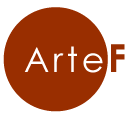ArteF
is proud to announce the second exhibition in its new
premises after the successful opening show on "Bauhaus
and Experimental Photography"
The exhibition will consist of around 40 photographic
works by Philippe Halsman, one of photography’s
greatest masters, ranging from his charming fashion and
advertisements works, to his portraits, among them the
famous portrait of Marilyn Monroe featured on the 1952
Life cover and Salvador Dalí "Dalí
Atomicus".
As Philippe Halsman’s work has rarely
been shown in Switzerland, his retrospective at ArteF
will be a unique event.
For three decades, from the Forties to
the Seventies, Philippe Halsman's fascinating portraits
of celebrities, intellectuals and politicians have been
published in the most significant magazines such as; Look,
Esquire, Saturday Evening Post, Paris Match and Life.
Life published his portraits on 101 covers, a record for
any artist.
In 1932, Philippe Halsman set up his first
photographic studio in Paris, his distinctive style soon
won him great reputation as one of Frances best portrait
photographers.
In the summer of 1940, when Hitler's troops
invaded Paris, Halsman obtained permission to enter the
United States with the intervention of Albert Einstein.
He arrived in New York in November 1940, with just his
camera and a few personal belongings in a suitcase.
In 1942 life for the first time published
one of Halsman’s shot’s and a long collaboration
between the photographer and the magazine began.
Halsman liked to compare his work in portraiture
to that of a psychologist who looks at his patients with
special insight. As he stated "It can't be done by
pushing the person into position or arranging his head
at a certain angle. It must be accomplished by provoking
the victim, amusing him with jokes, lulling him with silence,
or asking impertinent questions which his best friend
would be afraid to voice."
On the occasion of an assignment in 1941,
Philippe Halsman met the Spanish surrealist Salvador Dalí,
an encounter which led to a productive friendship, that
would last thirty years and generate one of his most impressive
and famous of works "Dalí
Atomicus".
"Dalí
Atomicus" is a masterpiece of technical ability
and fantasy, in which the artist, his canvas, furniture,
cats, and water all appear to be floating in the air.
In his New Yorker studio, Halsman suspended an easel,
two of Dalí’s
paintings and a stepping stool.
"Six hours and twenty-eight throws
later, the result satisfied my striving for perfection,"
wrote Halsman "My assistants and I were wet, dirty,
and near complete exhaustion—only the cats still
looked like new."
In 1950, when NBC commissioned Halsman
to create a photographic series of their most popular
of comedians, Halsman observed that comedians often jumped,
but always stayed in character. Through this realisation
his "jumpology" concept developed and he later
declared that the jumps revealed spontaneous character
that was otherwise hidden. "When you ask a person
to jump, his attention is mostly directed toward the act
of jumping and the mask falls so that the real person
appears."
In the spring of 1952, Life sent him to
Hollywood to photograph Marilyn Monroe. Halsman asked
Monroe to stand in a corner, and placed his camera directly
in front of her. Then Halsman, his assistant, and Life's
reporter staged a "fiery" competition for Monroe's
attention. "Surrounded by three admiring men she
smiled, flirted, giggled and wriggled with delight. During
the hour I kept her cornered she enjoyed herself royally,
and I took between 40 to 50 pictures."
Halsman was aware that showing someone’s
true identity had significance far beyond the needs of
the celebrity marketplace. "This fascination with
the human face has never left me. Every face I see seems
to hide and sometimes, fleetingly, to reveal the mystery
of another human being. Capturing this revelation became
the goal and passion of my life."
In 1958 Popular Photography named
him one of the "World's Ten Greatest Photographers"
along with Irving Penn, Richard Avedon, Ansel Adams, Henri
Cartier-Bresson, Alfred Eisenstaedt, Ernst Haas, Yousuf
Karsh, Gjon Mili, and Eugene Smith.
|

